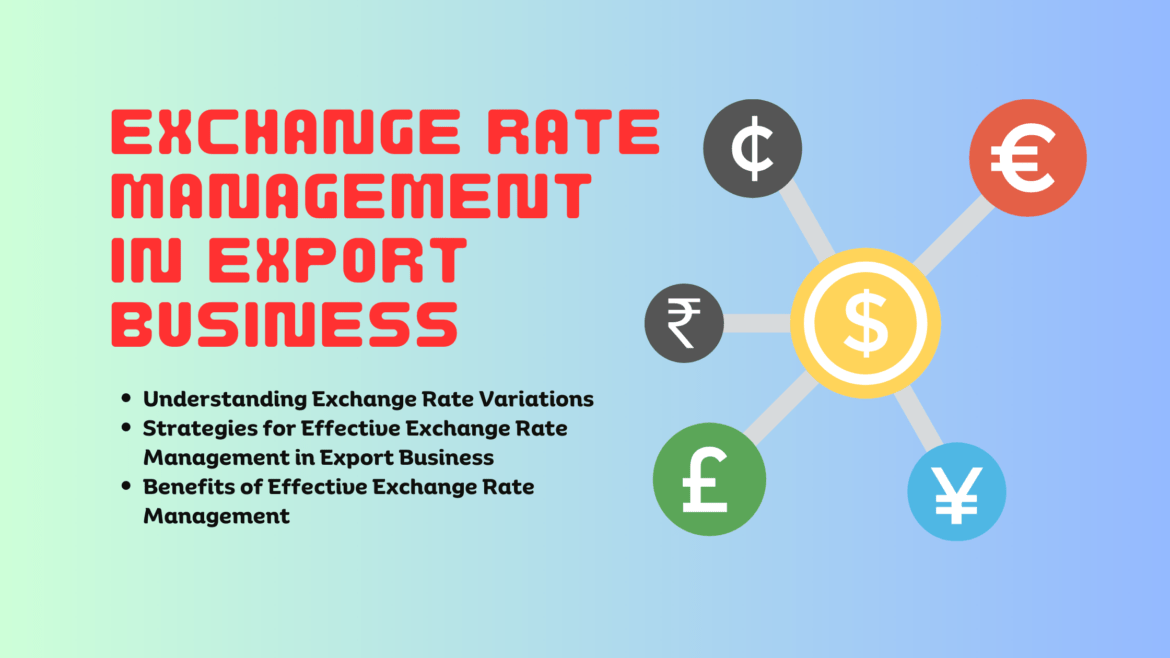The intricacies of exchange rate management in export business, exploring strategies to mitigate risks, enhance profitability, and ensure successful international trade operations. Export businesses are intimately tied to the fluctuations of exchange rates. The rise and fall of currency values can significantly impact profitability and competitiveness. To navigate these uncertainties, effective exchange rate management is crucial.
Understanding Exchange Rate Variations
1. What are Exchange Rate Variations?
Exchange rate variations refer to the fluctuations in the value of one currency against another. These fluctuations occur due to various factors such as economic indicators, geopolitical events, and market sentiment.
2. Impact on Export Business
For export businesses, exchange rate variations can have profound effects:
- Profit Margin Impact: Sudden currency appreciation can reduce profit margins on exported goods when converted back into the domestic currency.
- Competitiveness: Exchange rate fluctuations can affect the pricing of exported goods, influencing competitiveness in global markets.
Strategies for Effective Exchange Rate Management in Export Business
1. Forward Contracts:
A forward contract is a financial agreement that allows businesses to lock in a specific exchange rate for a future date. In the context of export business, this strategy involves entering into a contract to buy or sell a foreign currency at a predetermined rate. Forward contracts provide protection against adverse exchange rate movements, ensuring that the business can execute transactions at a fixed rate, regardless of future fluctuations. This strategy enhances price predictability and reduces the risk of sudden currency depreciation impacting profit margins.
2. Currency Diversification:
Currency diversification involves expanding the geographic reach of export sales across multiple markets with different currencies. By diversifying sales, a business reduces its reliance on the performance of a single currency. This strategy helps mitigate the impact of adverse exchange rate movements on overall profitability. If one currency experiences depreciation, the positive performance of other currencies can offset potential losses. Currency diversification also opens up opportunities in various markets, allowing the business to tap into demand without excessive currency risk.
3. Currency Hedging:
Currency hedging is a financial strategy that involves using derivatives to offset potential losses due to currency volatility. Derivatives such as options and futures allow businesses to establish positions that act as insurance against unfavorable exchange rate movements. For instance, an exporter can enter into an option contract to sell a specific amount of foreign currency at a predetermined exchange rate. If the exchange rate becomes less favorable in the market, the exporter can exercise the option and protect their revenue.
4. Monitor Economic Indicators:
Effective exchange rate management requires vigilance regarding economic indicators and events that impact currency values. Factors such as interest rate decisions, inflation rates, trade balances, and political stability can influence exchange rates. Monitoring these indicators helps businesses anticipate potential currency movements and adjust their strategies accordingly. Staying informed about global economic trends empowers businesses to make informed decisions based on evolving market conditions.
5. Pricing Strategies:
Pricing strategies play a significant role in managing exchange rate fluctuations. To mitigate currency risk, businesses can consider pricing their goods in the currency of the buyer’s market. This strategy helps maintain consistent pricing for buyers, regardless of changes in exchange rates. Additionally, offering flexible pricing options that account for potential currency variations can strengthen the business’s position in competitive international markets.
6. Continuous Evaluation:
Exchange rate management is an ongoing process that requires continuous evaluation and adaptation. Currency markets are dynamic, influenced by a multitude of factors. Regularly reviewing exchange rate movements and their potential impact on the business allows for timely adjustments. This could involve refining hedging strategies, diversifying into new markets, or revisiting pricing strategies to align with prevailing market conditions.
Benefits of Effective Exchange Rate Management
1. Risk Mitigation:
One of the primary benefits of effective exchange rate management is risk mitigation. By implementing strategies like forward contracts, currency diversification, and currency hedging, businesses can minimize the adverse impact of currency fluctuations on their profitability. These strategies provide a level of protection against sudden and unfavorable exchange rate movements.
2. Improved Forecasting:
Effective exchange rate management strategies, such as forward contracts, offer businesses greater certainty in revenue projections. With a fixed exchange rate for future transactions, businesses can more accurately forecast their financial performance. This improved forecasting aids in better financial planning, budgeting, and resource allocation.
3. Enhanced Competitiveness:
Managing exchange rate risks empowers businesses to maintain competitive pricing in international markets. When exchange rates are unpredictable, businesses that can offer stable and consistent pricing are better positioned to attract and retain customers. Effective exchange rate management ensures that exported goods remain competitively priced, irrespective of currency fluctuations.
4. Expanded Market Reach:
Currency diversification and strategic exchange rate management enable businesses to expand their market reach. By tapping into new markets with different currencies, businesses can seize opportunities for growth. The ability to explore diverse markets without excessive currency risk gives businesses a competitive edge and the potential for increased revenue streams.
Exchange Rates and the Extensive Margin of Exports (World Trade Organization)
Exchange rate management is a critical aspect of export business operations, influencing profitability, competitiveness, and market reach. By understanding the impact of exchange rate variations, implementing proactive strategies such as forward contracts, currency diversification, and currency hedging, businesses can navigate uncertainties with confidence.
Effective exchange rate management offers benefits beyond risk mitigation, including improved forecasting, enhanced competitiveness, and the opportunity to explore new markets. In a globalized world where currencies are in constant flux, mastering exchange rate management is essential for export businesses aiming to thrive in the international marketplace.
Understanding the Role of Letters of Credit


2 comments
[…] Exchange rate management in export business […]
Exchange Rate Management in Export Business